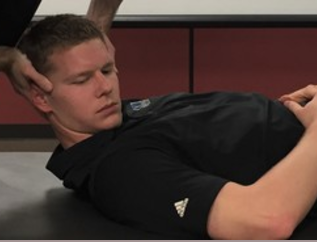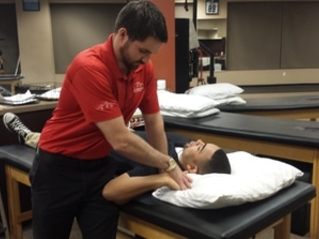- Home
- About Us
- TSPT Academy
- Online Courses
-
Resources
- Newsletter
- Business Minded Sports Physio Podcast
- Day in the Life of a Sports PT
- Residency Corner
-
Special Tests
>
-
Cervical Spine
>
- Alar Ligament Test
- Bakody's Sign
- Cervical Distraction Test
- Cervical Rotation Lateral Flexion Test
- Craniocervical Flexion Test (CCFT)
- Deep Neck Flexor Endurance Test
- Posterior-Anterior Segmental Mobility
- Segmental Mobility
- Sharp-Purser Test
- Spurling's Maneuver
- Transverse Ligament Test
- ULNT - Median
- ULNT - Radial
- ULNT - Ulnar
- Vertebral Artery Test
- Thoracic Spine >
-
Lumbar Spine/Sacroiliac Joint
>
- Active Sit-Up Test
- Alternate Gillet Test
- Crossed Straight Leg Raise Test
- Extensor Endurance Test
- FABER Test
- Fortin's Sign
- Gaenslen Test
- Gillet Test
- Gower's Sign
- Lumbar Quadrant Test
- POSH Test
- Posteroanterior Mobility
- Prone Knee Bend Test
- Prone Instability Test
- Resisted Abduction Test
- Sacral Clearing Test
- Seated Forward Flexion Test
- SIJ Compression/Distraction Test
- Slump Test
- Sphinx Test
- Spine Rotators & Multifidus Test
- Squish Test
- Standing Forward Flexion Test
- Straight Leg Raise Test
- Supine to Long Sit Test
-
Shoulder
>
- Active Compression Test
- Anterior Apprehension
- Biceps Load Test II
- Drop Arm Sign
- External Rotation Lag Sign
- Hawkins-Kennedy Impingement Sign
- Horizontal Adduction Test
- Internal Rotation Lag Sign
- Jobe Test
- Ludington's Test
- Neer Test
- Painful Arc Sign
- Pronated Load Test
- Resisted Supination External Rotation Test
- Speed's Test
- Posterior Apprehension
- Sulcus Sign
- Thoracic Outlet Tests >
- Yergason's Test
- Elbow >
- Wrist/Hand >
- Hip >
- Knee >
- Foot/Ankle >
-
Cervical Spine
>
- I want Financial Freedom
- I want Professional Growth
- I want Clinical Mastery
Sharp-Purser Test
Purpose: To assess the integrity of the transverse ligament/upper cervical spine instability.
Test Position: Sitting.
Performing the Test: The patient should perform a slight cervical nod. The examiner then places one hand on the forehead, while the other hand is placed on the spinous process of C2 (both arms should be parallel to the ground!). A posteriorly directed force is applied by the hand on the forehead, while the hand on the spinous process of C2 just stabilizes. There should be a firm end-feel. A positive test occurs if there is a sliding movement of the head or a decrease in symptoms (often neuro symptoms; “clunk” may occur).
Diagnostic Accuracy: Sensitivity: .69; Specificity: .96; -LR: .32; +LR: 17.3 (“Clinical assessment of atlantoaxial instability using the Sharp-Purser test”; article suggests diagnostic criteria is applied when subluxation is >4 mm.).
Importance of Test: Whenever you encounter a patient that has neck pain as a result of trauma, you should always inspect the integrity of the transverse ligament before any other exam measures. The transverse ligament is responsible for keeping the anterior facet of the atlas against the dens of the axis. It attaches on the medial side of each large, lateral process of the atlas with the anterior side of the middle part touching the odontoid process. This creates a wide space in the vertebral canal for the spinal cord to pass through, posterior to the transverse ligament. When the transverse ligament is damaged, the atlas can slide forward on the dens, decreasing the size of the vertebral canal for the spinal cord to go through. This can result in neurological symptoms, such as pain, weakness, a lump in the throat, etc. In this compromised position, any movements can impinge upon the spinal cord and cause potentially irreversible damage. The Sharp-Purser Test decreases symptoms by increasing the vertebral canal space. It does this by moving the atlas posteriorly relative to the axis (assuming there is a damaged transverse ligament). The Sharp-Purser test should be performed before the Transverse Ligament Stress Test, because the Sharp-Purser test works to reduce symptoms, while the Transverse Ligament Stress Test works to reproduce symptoms. (“Clinical Testing for the Craniovertebral Hypermobility Syndrome”).
Note: tests should only be performed by a properly trained health care practitioner.
Test Position: Sitting.
Performing the Test: The patient should perform a slight cervical nod. The examiner then places one hand on the forehead, while the other hand is placed on the spinous process of C2 (both arms should be parallel to the ground!). A posteriorly directed force is applied by the hand on the forehead, while the hand on the spinous process of C2 just stabilizes. There should be a firm end-feel. A positive test occurs if there is a sliding movement of the head or a decrease in symptoms (often neuro symptoms; “clunk” may occur).
Diagnostic Accuracy: Sensitivity: .69; Specificity: .96; -LR: .32; +LR: 17.3 (“Clinical assessment of atlantoaxial instability using the Sharp-Purser test”; article suggests diagnostic criteria is applied when subluxation is >4 mm.).
Importance of Test: Whenever you encounter a patient that has neck pain as a result of trauma, you should always inspect the integrity of the transverse ligament before any other exam measures. The transverse ligament is responsible for keeping the anterior facet of the atlas against the dens of the axis. It attaches on the medial side of each large, lateral process of the atlas with the anterior side of the middle part touching the odontoid process. This creates a wide space in the vertebral canal for the spinal cord to pass through, posterior to the transverse ligament. When the transverse ligament is damaged, the atlas can slide forward on the dens, decreasing the size of the vertebral canal for the spinal cord to go through. This can result in neurological symptoms, such as pain, weakness, a lump in the throat, etc. In this compromised position, any movements can impinge upon the spinal cord and cause potentially irreversible damage. The Sharp-Purser Test decreases symptoms by increasing the vertebral canal space. It does this by moving the atlas posteriorly relative to the axis (assuming there is a damaged transverse ligament). The Sharp-Purser test should be performed before the Transverse Ligament Stress Test, because the Sharp-Purser test works to reduce symptoms, while the Transverse Ligament Stress Test works to reproduce symptoms. (“Clinical Testing for the Craniovertebral Hypermobility Syndrome”).
Note: tests should only be performed by a properly trained health care practitioner.
References:
Aspinall W. "Clinical Testing for the Craniovertebral Hypermobility Syndrome." J Orthop Sports Phys Ther. 1990. Web. 08/18/2012.
Uitvlugt G, Indenbaum S. "Clinical assessment of atlantoaxial instability using the Sharp-Purser test." Arthritis Rheum. 1988 Jul. Web. 08/18/2012.
Aspinall W. "Clinical Testing for the Craniovertebral Hypermobility Syndrome." J Orthop Sports Phys Ther. 1990. Web. 08/18/2012.
Uitvlugt G, Indenbaum S. "Clinical assessment of atlantoaxial instability using the Sharp-Purser test." Arthritis Rheum. 1988 Jul. Web. 08/18/2012.
Copyright © The Student Physical Therapist LLC 2023




